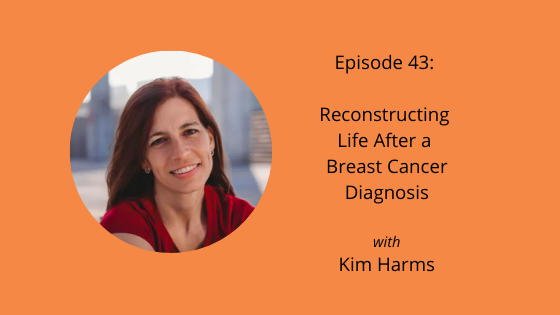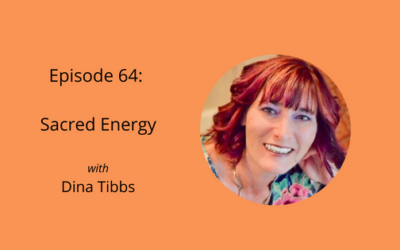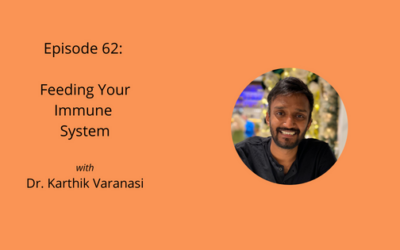Reconstructing life after a breast cancer diagnosis may seem difficult for some. For Kim Harms, it was just how the story unfolded. She confided in me that she felt there was a greater purpose in her breast cancer diagnosis. Kim felt that purpose was helping other women navigate the many nuances of having a mastectomy and breast reconstruction.
Kim’s cancer experience and the world of mastectomy.
Kim found a lump in her breast on her own. She wasn’t even doing a self breast exam! It showed up by rubbing against her shirt. Kim was diagnosed a month after her 40th birthday with no genetic predisposition. What a birthday present, huh?
But she didn’t ask, “why me?” She leaned in and found meaning in her experience. As a freelance writer, she thought about bringing other women’s stories of struggle to the forefront in order to help other women navigate those same struggles. The result is her new book, Life Reconstructed: Navigating the World of Mastectomies and Breast Reconstruction, which is available on Amazon.
You have so many options!
When it comes to breast cancer treatment, there are myriad options to choose from. The same is true for decisions around mastectomy and reconstruction. Some women choose lumpectomy over mastectomy. Some women choose to do reconstruction while others choose to remain flat, and not do reconstruction.
For mastectomy alone, there is the question of whether to use implants and what type of implant. Whether you can use muscle tissue from other parts of the body for the reconstruction and how that will affect function later on.
Another thing to consider is doing a single or double mastectomy. Do you only take the breast affected not knowing what (if anything) is in the other breast? Sometimes the cancer is so small it is not yet detected on a mammogram. Or it’s a diffuse type that isn’t normally detected on mammography screens. There are so many things to consider.
The affect on relationships.
One thing Kim found was that each decision has its own repercussions. Body image was a big thing that was affected by this decision and intimate relationships were consequently affected too.
Changing relationships is something I often hear survivors talk about whether it is with their spouses, their children, or other family members, and even friendships change too.
One really important thing we talked about was how to talk to your children about what you’re going through. How much do they want to know? How much can they understand? How much information can they handle? How should you share it? When is the right time to share?
Children are resilient, but they also know they are dependent on the adults in their life for their own survival and well-being and they can feel scared, with or without verbalization. They may not even know that’s what’s bothering them in order to be able to formulate what they want to say.
Finding faith in the hard things.
One of the things that gave Kim comfort in the process of navigating breast cancer was knowing that G-d was with her, not in the way that she felt she had answers for decisions, but more that she wasn’t alone. Kim mentioned one particular psalm which kept showing up in her life from a young age and how this verse helped her go through this hard time in her life.
Faith and prayer offered me a spiritual connection, comfort, peace, and calm when everything around me seemed scary as well, on more than one occassion.
During my journey, I felt there was a purpose for my suffering to help women who were diagnosed after me. I have now expanded that to men as well. But at the time, I was focused on coaching other women diagnosed with breast cancer.
For Kim, it was an opportunity for personal growth, for learning about yourself and how you handle adversity, and for gaining a greater sense of compassion for others. It was about learning how to communicate and make decisions with important people in your life.
Find your community.
It’s important to have a support system to help you through the tough times. For Kim that meant a group of women in an ongoing texting group she could share how she was feeling, something funny, or struggles, concerns, or joys. Her husband was an Elder in their church and had his own support system too. Which is important to remember that our partners, caretakers, and spouses also need a support system that doesn’t include the patient.
Her family was a big help to her family at this time as well.
Managing lifestyle factors.
In the spirit of reconstructing life after breast cancer, three things that Kim mentioned on the podcast are exercising, controlling her stress level, and adopting three healthy food practices. The three nutrition practices are drinking green tea, eating blueberries, and adding broccoli to their family’s regular meal rotation.
“I knew I couldn’t do all the things, but if I just did a few things, I could stay on top of that.”
Kim Harms
Since her stress was mostly caused by the uncertainty of the diagnosis, having a plan of action helped her control the stress of the situation. Being active was also a part of Kim’s recovery.
Here are some of my favorite moments from this episode:
- 2:32 Kim’s cancer experience.
- 3:51 Publishing Life Reconstructed: Navigating the World of Mastectomies and Breast Reconstruction.
- 6:59 The inspiration for writing the book.
- 8:33 Finding faith through diagnosis and recovery.
- 14:50 Being called for a higher purpose.
- 16:23 Lifestyle factors helpful in getting through the tough times.
- 25:30 Adopting healthy nutrition practices.
- 28:10 Genetic testing doesn’t always hold the key to the answers.
- 31:02 Family, friends, and community.
- 40:58 Finding purpose in helping others navigate the reconstruction process.
- 43:48 Mastectomy pillows after surgery.
- 46:33 Young vs. Middle-aged survivorship.
- 49:56 This is not a boob job!
Links mentioned in this episode:
A new episode is released every second and fourth Thursday of each month.
Subscribe & Review in iTunes
Not subscribed to the podcast yet? Subscribe today so you don’t miss out on upcoming new content! Trust me, this is stuff you’re not gonna wanna miss! Don’t know how to review a podcast? Check out this article I wrote about rating and reviewing a podcast.









